A GREAT TIME FOR A CHAIN OF SPEED SHOPS

Back in 1963, a small speed shop opened on East Baseline Avenue in San Bernardino, CA, and through the efforts of the proprietor Harry R. Eberlin, along with a key group of loyal employees that were there at or near the start (in particular Mike Cunningham, Jimmy Patterson, Jim Cowell and Bill Blough), this single store would grow by leaps and bounds and in time take the automotive racing parts world by storm. The business would flourish at a rapid rate of speed and become the largest chain of speed shops ever, and the empire Harry Eberlin had started would also materialize into a serious player in the performance industry as a whole.
Eberlin was a car guy and loved fast cars and speed, so much so that as a youth he had been caught street racing on more than one occasion and even had to spend time in jail because of it! Once he turned his love of fast cars to selling parts and not racing on the street, things started to turn around for him, and his future became very bright. This business venture turned out to be very, very lucrative for him, although it certainly didn’t happen overnight.

This was the Van Nuys Super Shops and being located right on Van Nuys Blvd, it was highly visible and very successful! At the time it was built, 1977, the Southern California car cruising scene was alive and well, and Wednesday nights saw enthusiasts driving up and down the boulevard endlessly. Muscle cars, hot rods, custom vans, Cal Bug VWs, you name it! There was so much action that the store extended their hours to 9pm Wednesdays as there was plenty of foot traffic and buying customers.
DIRECT CONNECTION PARTS SOLD AT THE STORES
Of course, the inventory of speed shops include a wide variety of aftermarket equipment, manifolds, carburetors, camshafts, headers, shifters, wheels, tires and the shelves were stocked with items for numerous makes of Detroit iron. And as the Super Shops grew, the move was made to become a Mopar® Direct Connection WD (warehouse distributor) and as such, when the first Super Shops Funny Car program was being set up, Direct Connection joined up and the logo was displayed on both the Plymouth Arrow and the Dodge Van. With the shelves at the company warehouse (then located in Colton, CA) now stocked with popular “P” part numbers, sales sparked up in the stores once the Mopar customers learned Direct Connection items could be purchased there, no need having to go to a new car dealership.
The first set of Mopar Direct Connection 426 HEMI® engine heads sold by Super Shops (Van Nuys store) went to Roland Osborne, who at the time was the founder/president of the National HEMI Owners Association. Because of the stores being located in the Los Angeles area, many overseas car fanatic visitors were Super Shops customers, and because Mopar vehicles were very popular worldwide, Direct Connection parts were purchased with final destinations being in Sweden, Norway and other countries including Japan and Australia.
Super Shops was growing by leaps and bounds and as the number of stores grew, there were record sales from the suppliers, most especially BFGoodrich and the T/A Radial tires, and at low prices! Radio advertising helped greatly, and two of the biggest promotions were “Hedman Hedders for $39.95” and “BFG T/A Radials for $39.95”, plus “Holley carburetors for $39.95”. Those were real prices, the tires were 13-inch diameter, the carbs were 600 cfm #1850 4-barrels (with manual choke) and the Hedders were all across the line for any V8 application! It should be pointed out Hedman always referred to their products as “Hedders” and not the normal “header” spelling.
It was 1980 when the Super Shops purchased both Mallory Ignition and Sig Erson Cams, and it was a natural as the chain was the number-one customer of both of these companies with the high volume. 1980 was the final year for the Funny Car program, Harry had decided “enough” even after Ed McCulloch had won the NHRA U.S. Nationals with the car, gaining a ton of media attention. The fact remained, it was an expensive program and that car was also the last “house car” to ever run out of Ed Pink Racing.
A few years later, there was a renewed interest by Eberlin to get the name “Super Shops” back out on the drag strips, plus with him also owning the ignition and cam companies (the Sig Erson name was shortened to Erson Cams) there was a deal made with Don Garlits to be the new “rolling billboard” for not only Super Shops, but also large Mallory and Erson markings.
Turned out to be a huge success! “Big Daddy” Garlits did extremely well, won a World Championship and the magazines gave lots of “ink” to the Super Shops-backed drag racing legend. Mopar featured the Garlits dragsters that ran the Super Shops name in large letters and there was no question that Eberlin’s decision to back Don Garlits was brilliant. As the company kept expanding to states in the Midwest and Eastern states, there was sales galore.
Another good marketing decision was to go with Eddie “The Thrill” Hill and his Top Fuel dragster (after Garlits had retired). With a bright yellow car and huge “SUPER SHOPS” markings, it was another amazing sponsorship program as Hill became the very first in history to run down the 1/4-mile drag strip in under 5 seconds, doing it at the Texas Motorplex in April of 1988 with a barrier-breaking 4.990 record run. That was a big deal!
The high-water mark came for Super Shops in the mid-1990s when there was a total of 165 stores, and for a multitude of reasons, on or about December of 1997, the once unstoppable Super Shops filed for bankruptcy and at that time there was an effort to find a buyer of the chain, but it never happened. Complete store inventories were sold off at pennies on the dollar and all remaining stores were closed by early 1998. It was a sad time for many and the downfall of the company surprised a great many in the industry.
The focus of this story isn’t the details of their demise, but rather an overview of the history of the company, showing the racing of Mopar vehicles, selling Direct Connection (and later Mopar Performance) parts, plus the huge impact the company made on the industry. It went from a single store in San Bernardino to then becoming a mega-sized nationally known retailer of high-performance equipment, which included high-performance parts and pieces for Mopar muscle machines!
HEMI ENGINE-POWERED SUPER NANOOK

In 1977, the “Win This Car” promotion was launched and it involved running and giving away a specially constructed AA/FA (Nitro Fuel Altered) car owned by Super Shops and driven by Dave Hough. This car was known as the “Super Nanook” as a tribute to the numerous “Nanook” racecars previously campaigned by Hough. No gimmicks and free entry in the contest at any of the stores.
The aftermarket suppliers’ logos on the car were not for any contingency program, they were industry participants in the program with product credit provided in exchange for the publicity gathered by the popular car!

Here’s a shot of the give-a-way AA/FA sitting outside the company warehouse in Colton, CA, with the California sunshine highlighting the beautiful aluminum “marbleized” anodizing on the side panels and fuel/water tanks. The chassis was built by Race Car Productions in Rialto, CA. This car was very successful in generating exposure for the then-small (seven) chain of Southern California speed shops.


Dave Hough firing up the Mike Demarest-tuned Donovan HEMI engine-powered racecar, and while it was a potent performer, the move soon took place to step up to a Gen II HEMI engine, which was the way to make it even quicker and faster.
GREAT EXPOSURE IN THE DRAG RACE MEDIA

With the upgrading of an aluminum (Milodon VII Liter block) Gen II Chrysler HEMI engine for added power, the Super Nanook was now considered state-of-the-art in every way for Fuel Altered racing, and the car caught the attention of the weekly publication Drag News for their April 16, 1977, cover image. The ink gathered by the car was now growing to a national level!

Company founder Harry Eberlin took a real interest in the racecar program (shown here in brown shirt) and would often accompany the car at races and events. The racecar give-a-way program was an important ingredient in spreading the word of this aggressive and fast-growing chain of high-performance and tire/wheel stores on the West Coast. This was not a sponsorship by the Super Shops; Eberlin owned the car and all the equipment. The racecar featured beige and brown Super Shops colors and double-s stripe logo.
CHRYSLER NITRO HEMI GURU ED PINK

With Dave Hough working on the car, Harry Eberlin (left) listens to Ed Pink (right) while the Super Nanook is being run at the track. Pink’s involvement became more and more involved with the move to the Milodon HEMI engine, and things were gearing up for his further association with Super Shops racing program.
To haul the Super Nanook, a Dodge 600 Car Hauler was purchased from Dodge Pro Stock racer Larry Huff, repainted with colors to match the racecar, plus the logos from the participating aftermarket manufacturers were proudly display. The big hauler was known affectionately as “Godzilla” by the race team and Super Shops employees.
OCIR: A NIGHT TO REMEMBER
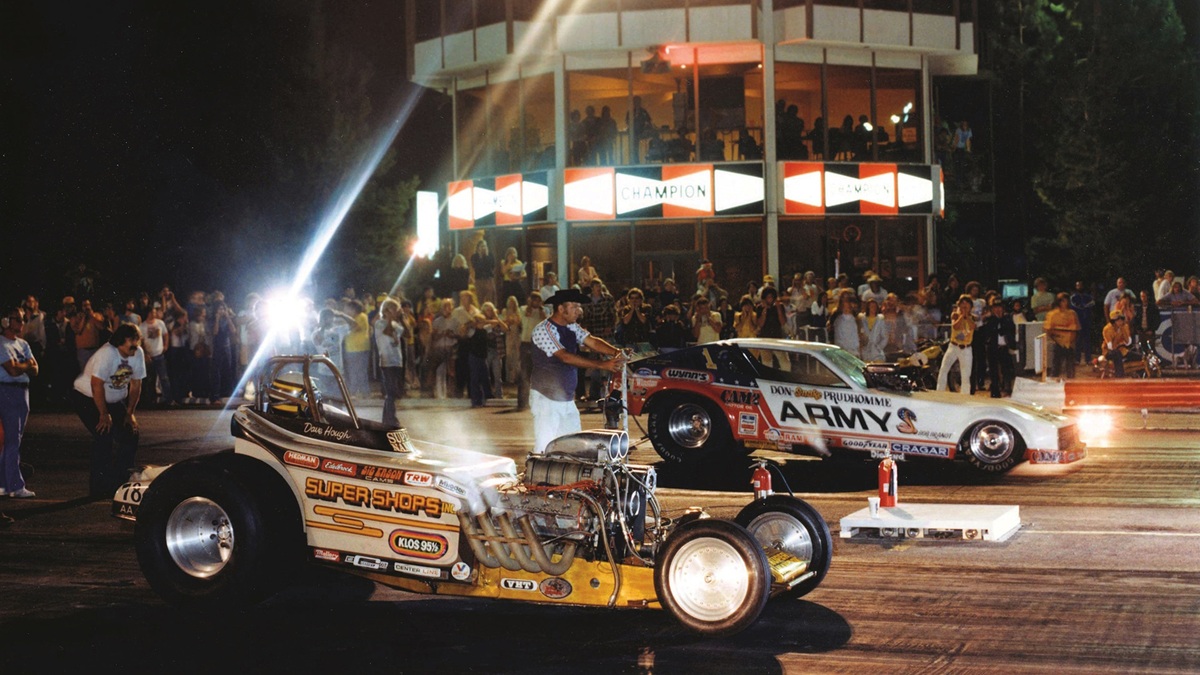
“Pure pandemonium” broke out according to Dave Hough when the Super Nanook ran an unheard of 6.18 e.t. in qualifying, at 233 mph, at the PDA Championships at OCIR on July 31, 1977. Ace photographer Rick Shute was at the right spot on the track when the final round saw the Super Shops car run up against Funny Car hero Don Prudhomme in this infamous shot! After beating the Funny Cars of Gary Densham, Gary Burgin and Jim Dunn, Hough had earned his way to the finals. Unfortunately, the roll cage-mounted wing had blown off on the run against Dunn, so for the finals there was going to be a problem for the Super Nanook – no downforce as it goes down the track against Snake. Told to stage first by starter Larry Sutton, and to leave the instant Prudhomme lights the second light, Hough shot out of the gate way ahead of the Plymouth Arrow; however, down track he lost stability and Snake blew past for the win. It’s # 7740-1-1 in the Auto Imagery library and still a highly popular print!
LUCKY WINNER

Ontario Motor Speedway was the home of the NHRA World Finals and that’s where Dave Hough did a final burnout in the car. The Super Nanook was given away to a lucky winner, who immediately proclaimed that he was going to put that nitro HEMI engine into a boat! Pictured is the contest winner Jim Perkins (left), Super Shops owner Harry Eberlin (center) and Mike Cunningham (right), the in-house marketing wiz (employee #2) that dreamed up the concept of the give-a-way program. The car was valued at $25,000.
THE MOVE TO PLYMOUTH ARROW FUNNY CAR
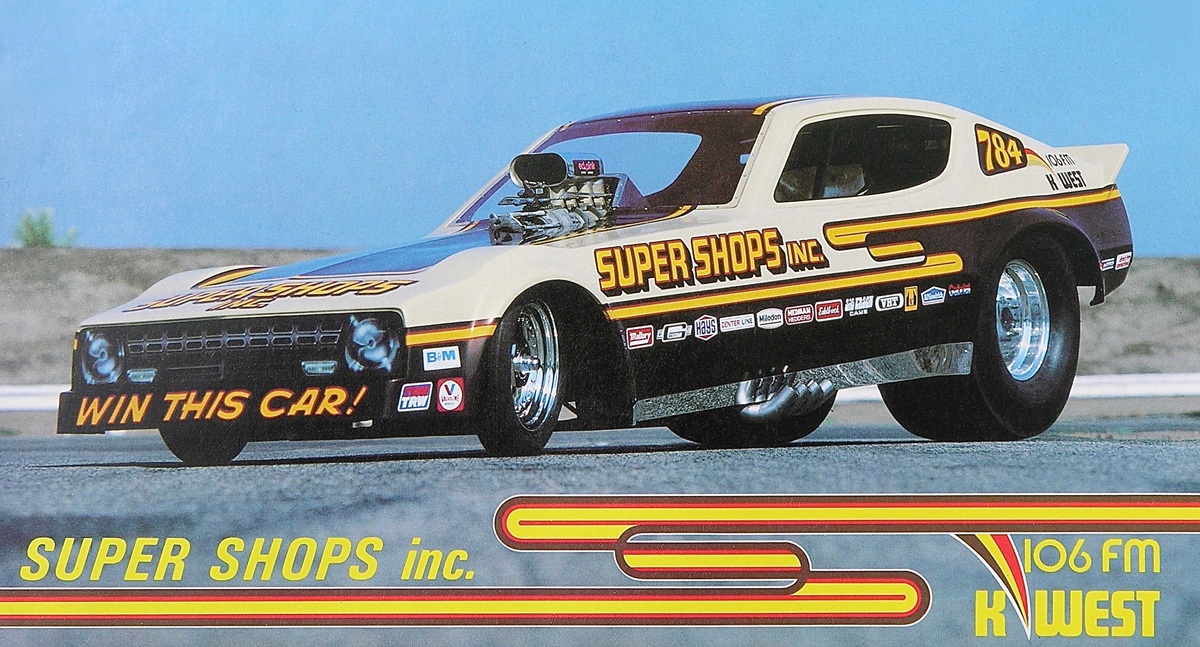
As a follow-up to the Super Nanook promotion, for 1978, a Plymouth Arrow AA/FC was built as a give-a-way car, state-of-the-art chassis by Jaime Sarte with power from an Ed Pink-prepped HEMI engine. It was an “in-house” Pink car and was run and maintained out of Pink’s Raymer Street, Van Nuys shop. Initially, Dave Hough continued as the driver. This car was valued at $40,000 and given away at the 1978 NHRA World Finals at Ontario Motor Speedway.
2ND PRIZE: $15,000 CUSTOM DODGE VAN
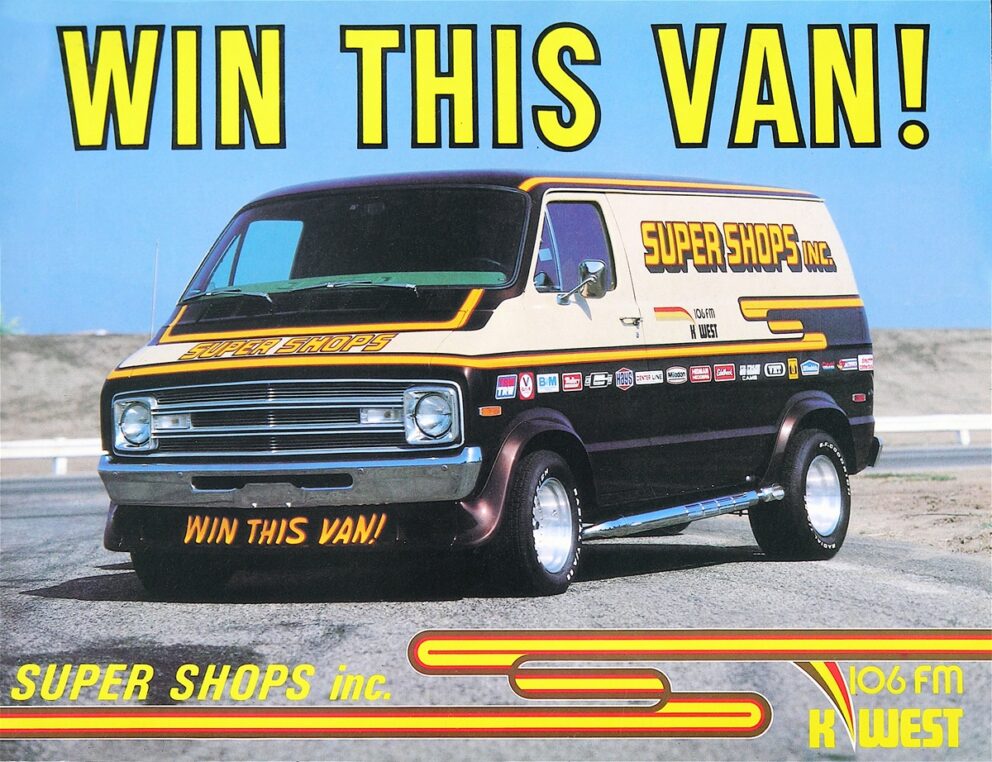

In addition to the racecar, a customized Dodge Van was also given away for ’78, complete with custom paint with wheel flairs, customized interior, Centerline Truck Wheels, BFGoodrich radials and Thrush side pipes. Direct Connection was among the logos that were displayed on the sides. This custom van was valued at $15,000 and also given away to a lucky winner at the 1978 NHRA World Finals at Ontario Motor Speedway.
INDUSTRY PUBLICATION COVER
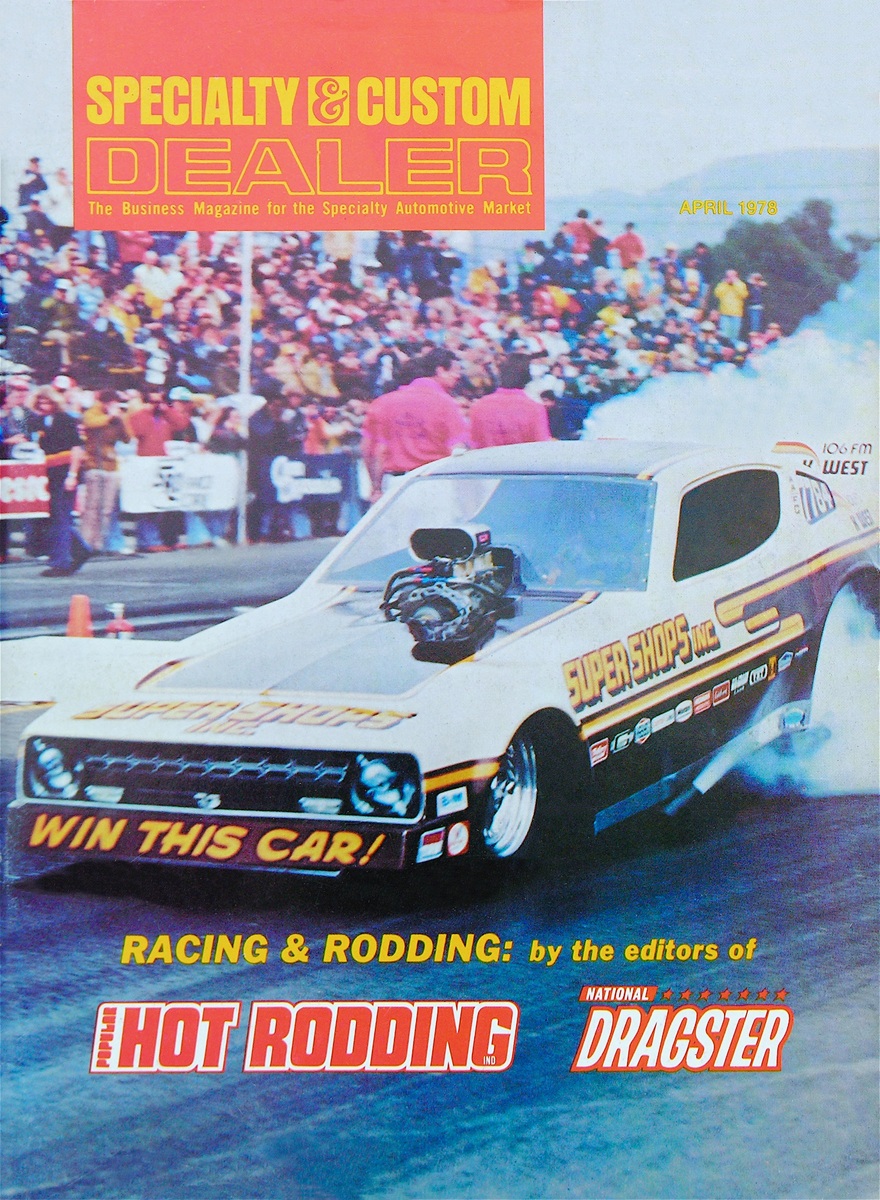
The leading trade publication gave exposure to the Super Shops Plymouth Arrow racecar give-a-way program. This April 1978 cover shot was seen by members of the aftermarket industry, and if they were from the mid-west or east coast, chances are they had, at this point in time, never heard of Super Shops or Harry Eberlin. In the next few years to come, that would dramatically change.
HEMI THRASH IN-BETWEEN ROUNDS

At a nighttime race at OCIR, Crew Chief Bernie Lewis working the RH-side, Ed Pink was inspecting the LH-side of the engine, Mike Cunningham is looking on. The move had taken place away from the Milodon block to a Keith Black aluminum block, and everything on this car was of the latest technology in the class, no expense spared.
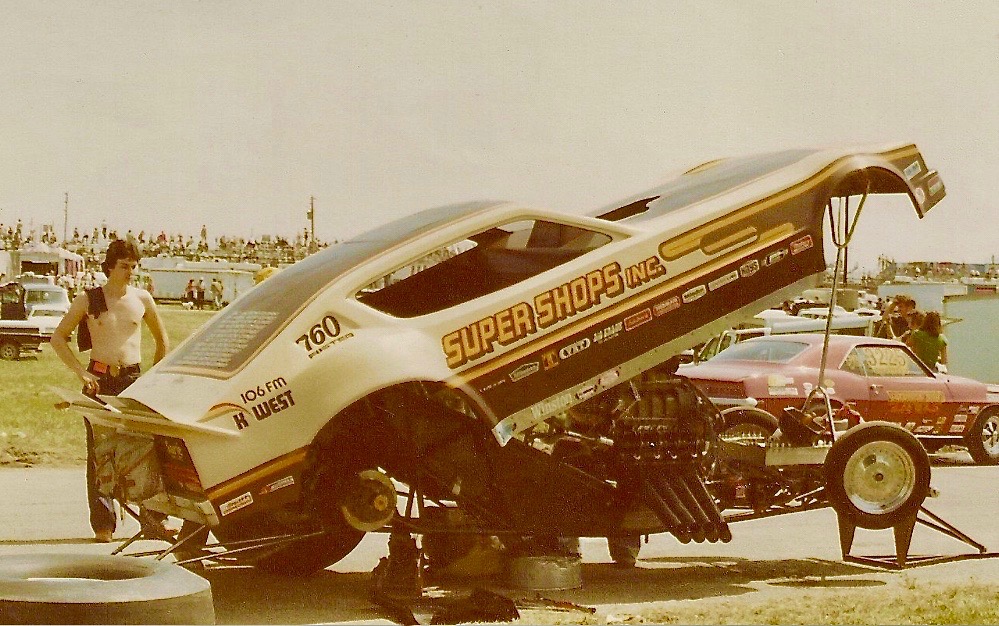
The rear window area of the car now had 12 listings of the various Super Shops locations, and as the company expanded, the Funny Car was entered in competition in those states, especially at NHRA national events. Great publicity for the existing stores plus a way to introduce the name to enthusiasts in general.
NATIONAL DRAGSTER COVER
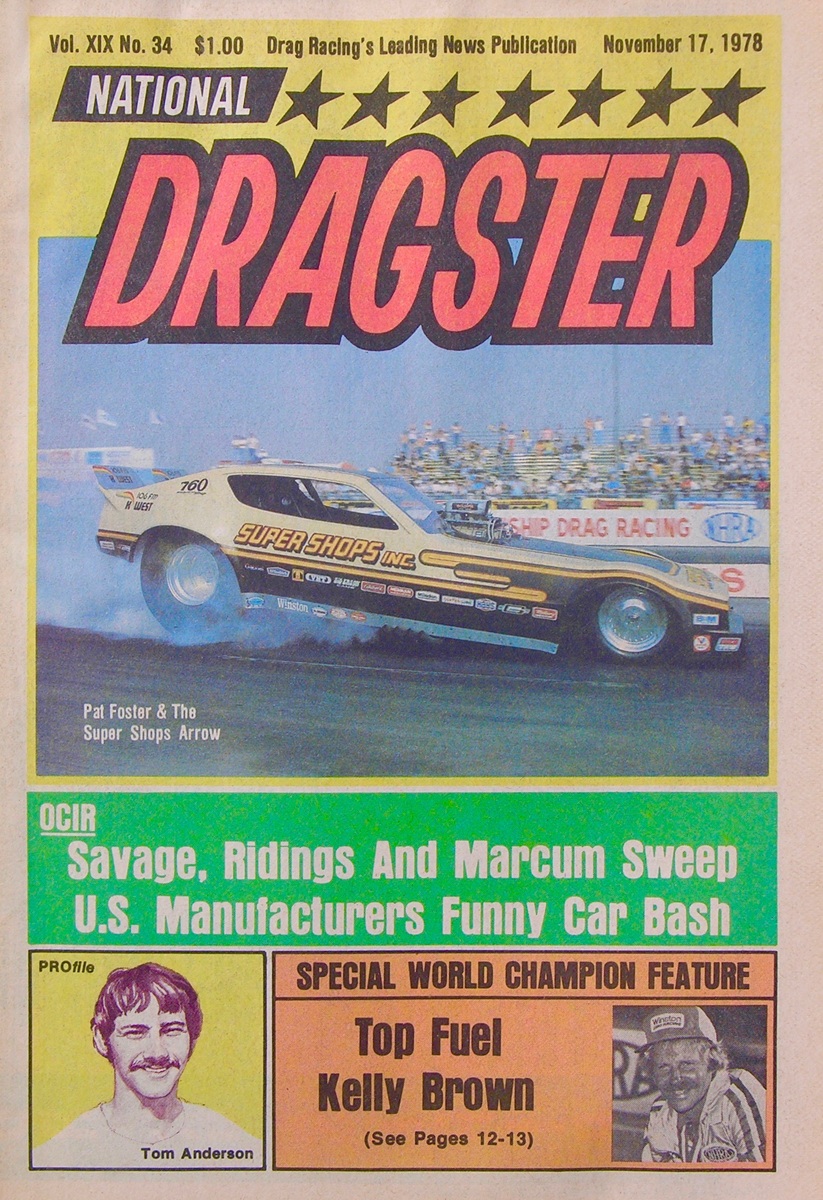
NHRA’s National Dragster featured the Pat Foster-driven Super Shops Arrow on their November 17, 1978 cover. Foster was chosen by Ed Pink to assume driving duties for the car, as he was an experienced driver with lots of credentials.
LINDA VAUGHN

Announcer Steve Evans talks with Linda Vaughn and one of the Hurstettes, it was on the starting line at OMS (Ontario Motor Speedway) during the 1978 NHRA World Finals, with Chief Starter Buster Couch looking on. Why? They were about to pull a name out of a Centerline wheel to announce the sweepstakes winner of the Super Shops Funny Car!!
SECOND-GENERATION FUNNY CAR
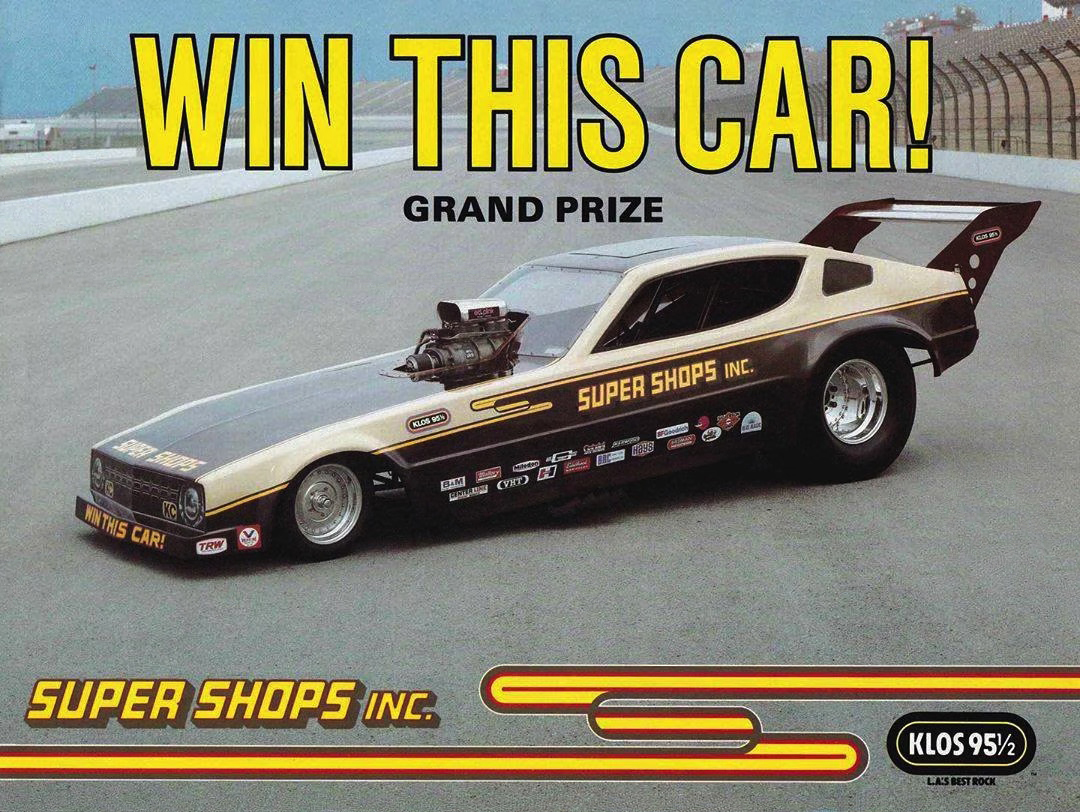
For 1979, there was a very unusual version of the Super Shops Funny Car, it continued as a Plymouth Arrow; however, the chassis builder, Race Car Productions, Rialto, CA, created some rather unique features never seen before in the class. Up front, to eliminate the tire clearance “bubbles” on the body, there was a set of 13-inch diameter Centerline wheels, 2-inch less diameter than what was standard in the traditional building specs. The rear of the car received a Top Fuel-style wing that was mounted up high with aluminum mounting plates.
All this was part of the car when the publicity shots were taken. However, the folks at the NHRA were not going to allow such radial changes, so the actual Super Shops Funny Car that ran on the track for 1979 had traditional front wheels and the standard body-mounted rear spoiler.
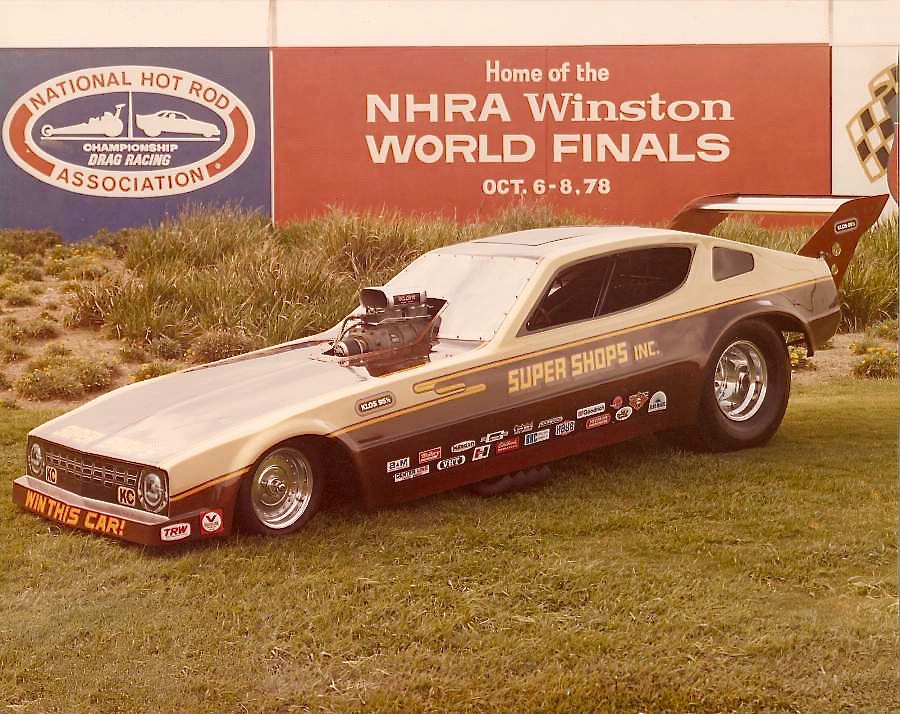
Except for a preview burnout that took place during the end of the 1978 racing season (World Finals), this 1979 car never ran on a drag strip, and was only used as a show car touring the various Super Shops store locations and SoCal car shows. It wasn’t legal as to NHRA rules, and clearly they weren’t interested in any of the “innovations” that were done to the car.
JOINED EXCLUSIVE 5-SECOND CLUB

With Pat Foster at the controls and ace wrench Bernie Lewis calling the tuning shots, the 1979 edition of the Super Shops Plymouth Arrow Funny Car recorded a 5.99 elapsed time at Fremont, CA, at an NHRA Division 7 Points Race, April 8, 1979. This marked it as the official third member of the very prestigious Cragar Five-Second Club for Funny Cars, which included Don Prudhomme and Raymond Beadle.
THIRD-GENERATION AND FINAL FUNNY CAR
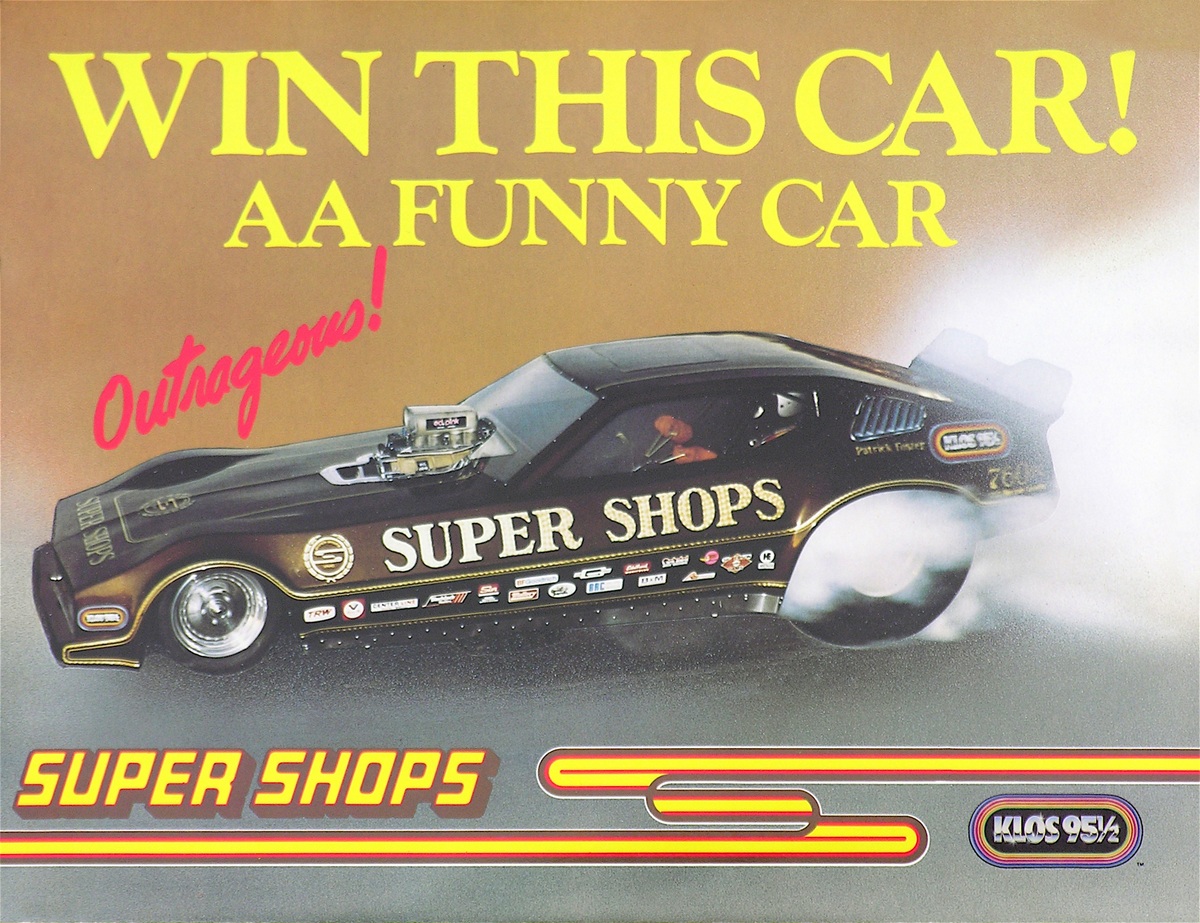
Artist Kenny Youngblood really added a “classy” look to the 1980 Plymouth Arrow Funny Car, changing up the overall look with lots of gold leaf on the lettering and stripes over dark metallic brown paint. KLOS radio continued on as business-to-business supporter and the driver was listed as “Patrick Foster” at the start, later replaced by Ed “The Ace” McCulloch.

The 1980 give-a-way program included 12 random customized cars, all outfitted with Centerlines wrapped with BFG tires. This rendering was done by Youngblood and the new look included a gold crest with the “SS” logo and Super Shops wording positioned inside.
PREVIEW: NATIONAL DRAGSTER
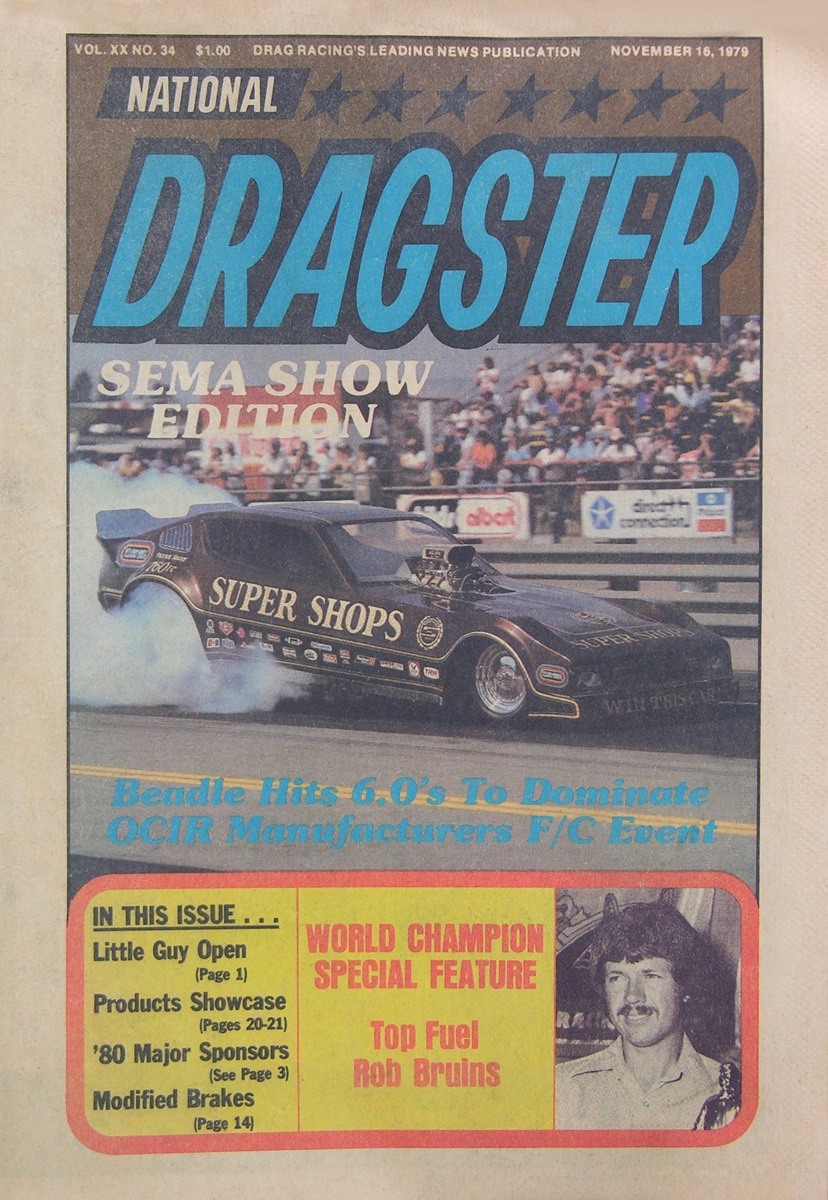
It was the 1979 World Finals at Ontario where this cover shot was taken, Pat Foster doing a burnout to show the crowd the upcoming 1980 Super Shops Funny Car.
PLAYBOY AD
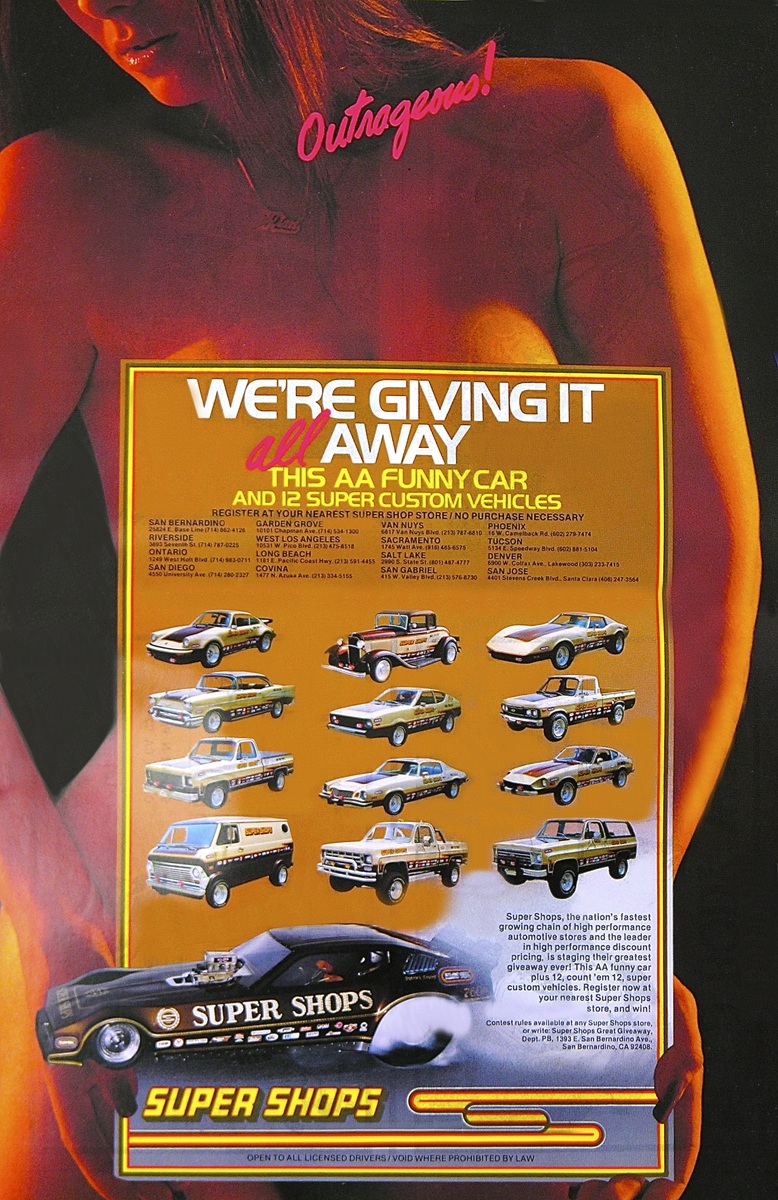
A particularly flamboyant advertisement appeared as a two pager in Playboy Magazine, as a provocative way to get the word out of the 1980 Super Shops give-a-way promotion. There were 12 stores at the time in California, Utah, Arizona and Colorado.
BACK-UP CAR USED FOR CAR SHOW DISPLAYS

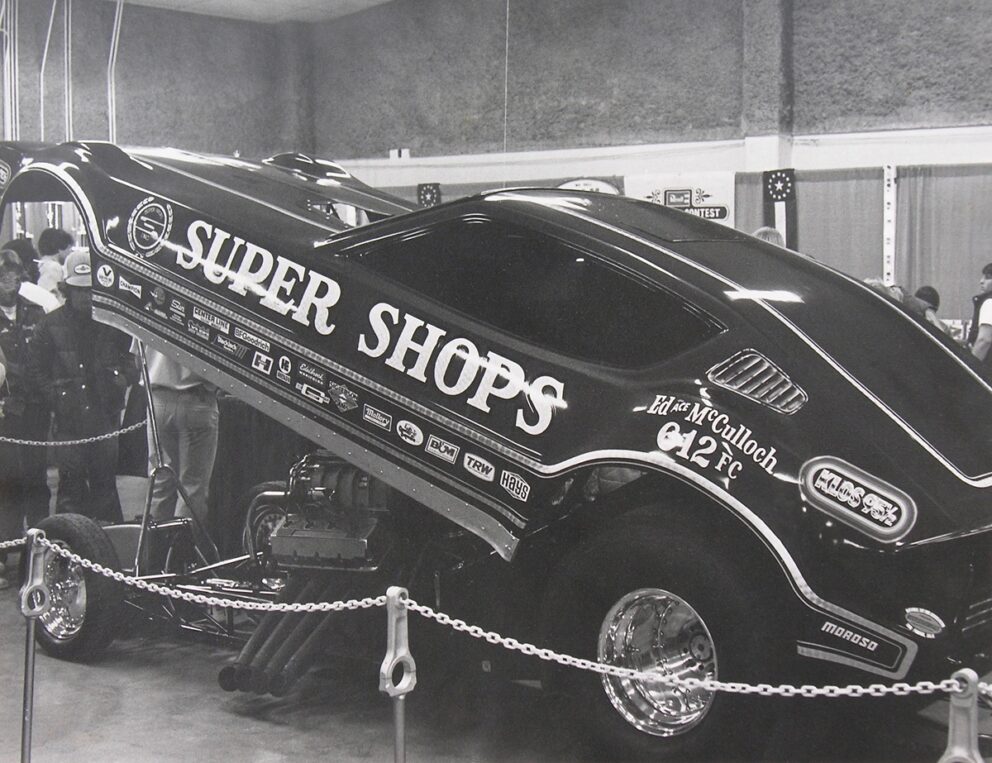
Because anything can happen when campaigning on the NHRA and match race circuits, all three years of the Funny Car program there were back-up cars ready to be put into service if needed, and traveling to various stores and car shows for display. A lot of consumers saw these Super Shops Arrows in action on the race tracks, and/or static displays (shown here at an R.G.Canning event).
“BIG DADDY” DON GARLITS

As a test sponsorship for the 1985 NHRA Winternationals, Harry Eberlin rolled the dice and supported long-time dragster racer Don “Big Daddy” Garlits, who at the time many trackside observers thought was all washed up as a contender in the Top Fuel class. The gamble paid off well as with the funding Garlits received from Super Shops (full sponsorship for three years), the result was an NHRA World Championship title, many wins, as well as getting the streamlined Super Shops dragster inducted into the Smithsonian!
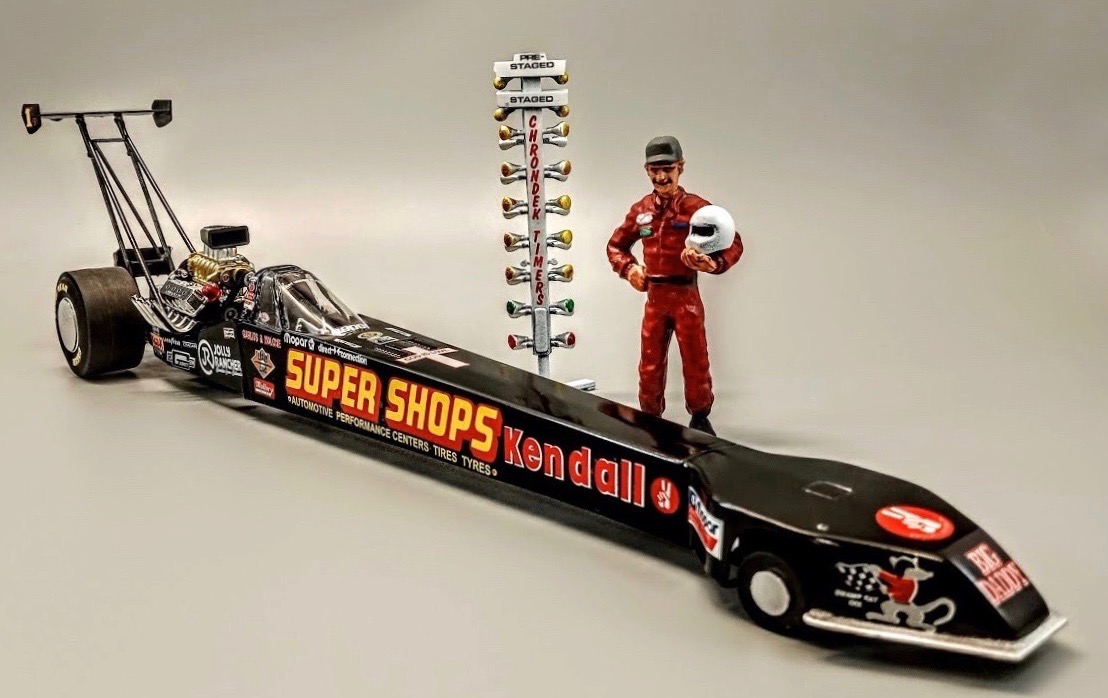
A popular 1/25th plastic model kit with builders is the Atlantis “Don Garlits’ Swamp Rat XXX Dragster” which has 80 parts and can be detailed as pictured by experienced modelers. Measuring over 14 inches in length and is available from numerous sources. SKU# H7152 includes Don Garlits figure. The Christmas Tree comes from the Atlantis Mongoose Rear Engine Dragster kit, SKU# M7529.
CENTER SPREAD MAGAZINE AD
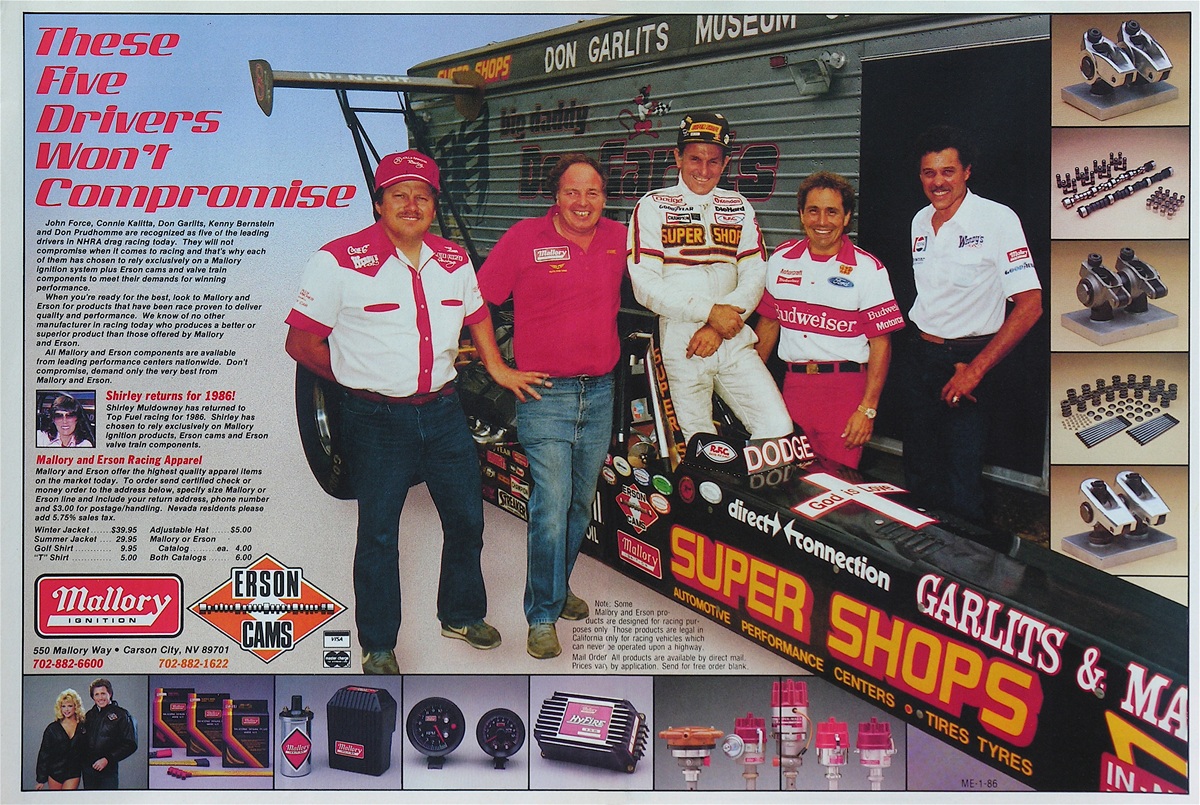
This 1986 center spread magazine ad for Mallory Ignition and Erson Cams featured Don Garlits and his Super Shops sponsored car, which included “Direct Connection” and “Dodge” markings displayed predominantly. The advertisement also featured other Mallory/Erson product users John Force, Connie Kalitta, Kenny Bernstein and Don “The Snake” Prudhomme. Add in the Shirley Muldowney “Returns for 1986!” announcement (another Mallory/Erson supported car) which resulted in a mighty impressive roster of drag racing royalty! It was in effect a multi-purpose ad: Mallory, Erson and Super Shops.
FIRST IN THE FOURS EDDIE HILL
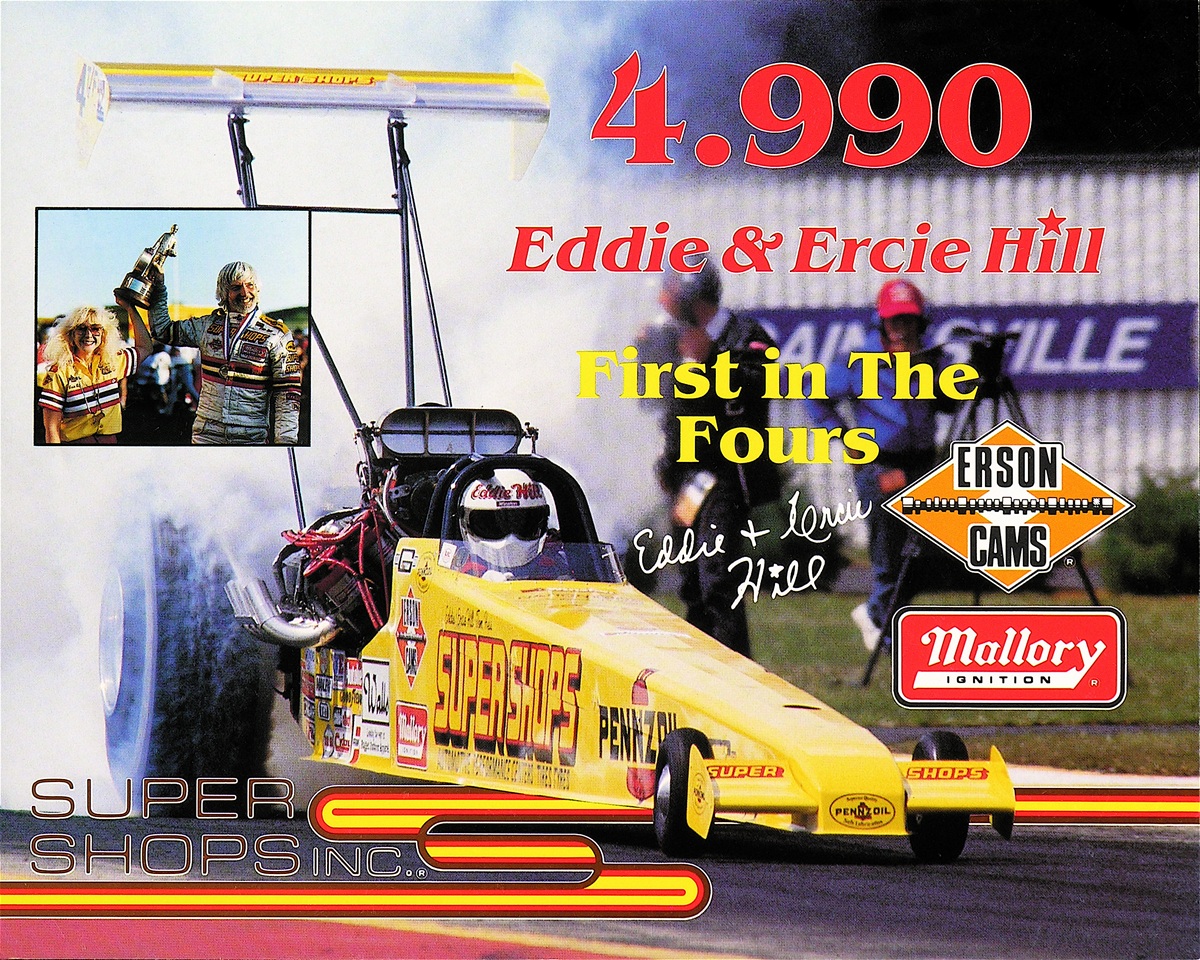
Next came the Eddie and Ercie Hill Top Fuel sponsorship, and it was April 9, 1988, when the big news came out of Ennis, TX, where at the Texas Motorplex the car broke into the 4-second zone with a 4.990 blast down the quarter-mile! This marked the first time in drag racing history the 5-second barrier was broken… and that same season the Super Shops dragster ran a 4.936-second run in Houston. Major PR came and it proved to be a wise marketing move to get the Super Shops/Mallory/Erson markings boldly on this car! The machine was called the “Nuclear Banana” after the record runs.
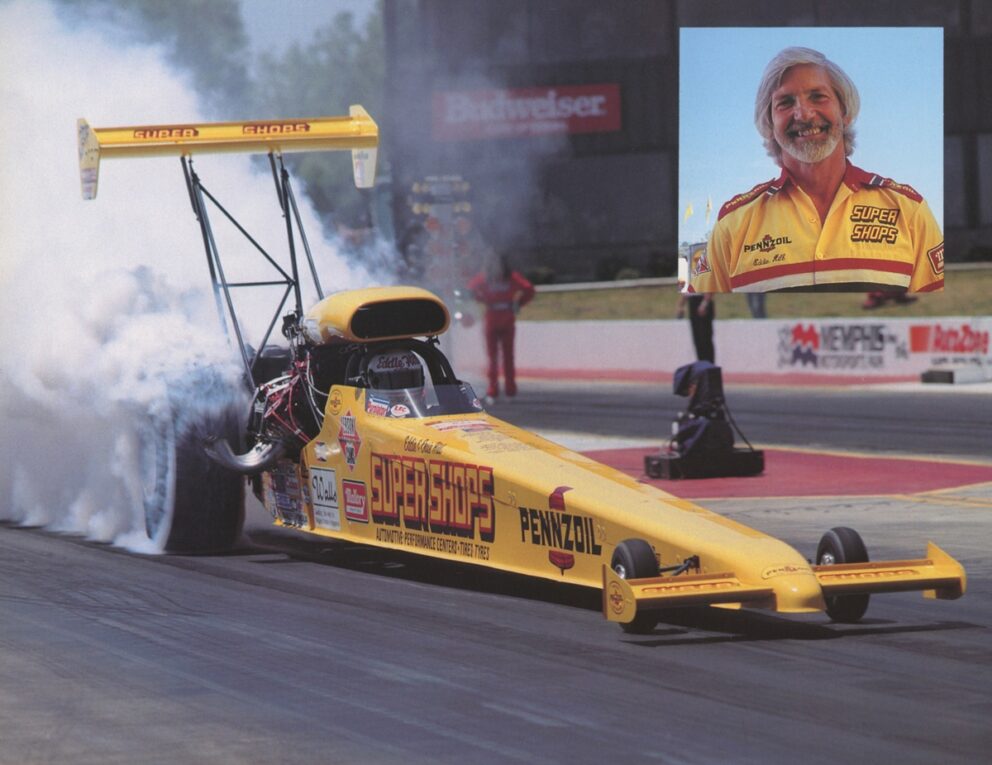

“First in the Fours” was a big deal and as such the car always received a ton of media attention. By this time frame, there were Super Shops stores also in Alabama, Arkansas, Florida, Georgia, Illinois, Indiana, Iowa, Kansas, Kentucky, Louisiana, Missouri, New Mexico, North Carolina, Ohio, Oklahoma, Oregon, Tennessee, Texas, Washington and Wisconsin.
EDDIE, ERCIE AND SUPER SHOPS OWNER HARRY EBERLIN
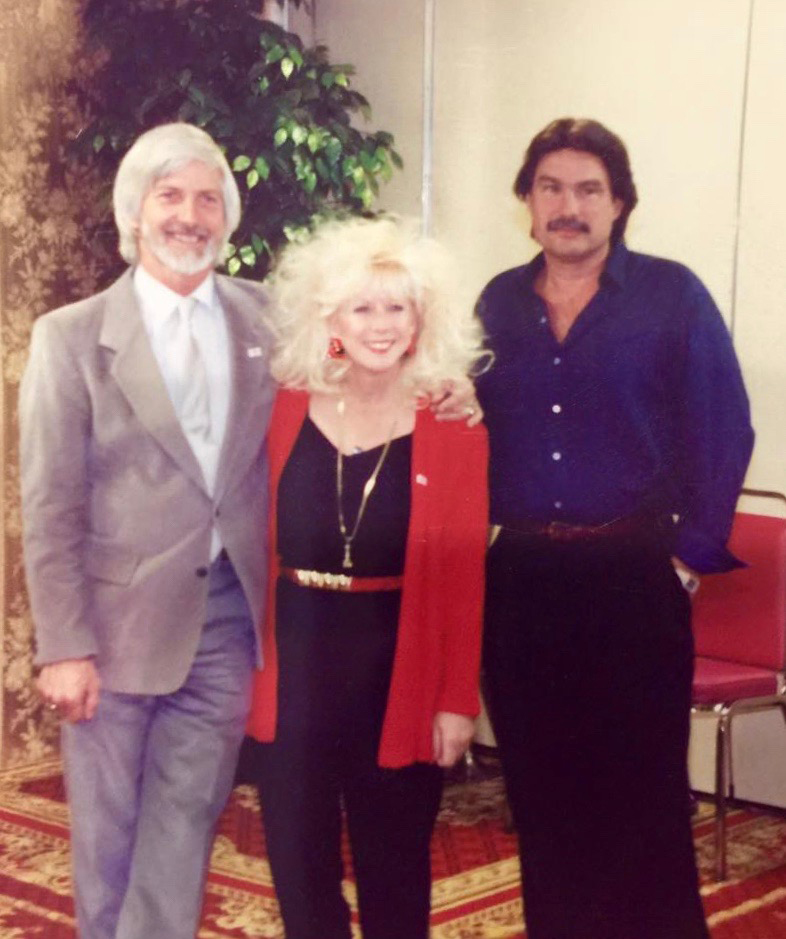
Here’s a shot of company president Harry Eberlin at a corporate function during the Eddie Hill sponsorship era. With the bright yellow car and the record run, the Super Shops name (along with Mallory and Erson) were well represented on the race tracks along with the Diamond P Sports televised events.
MOPAR DOOR SLAMMERS
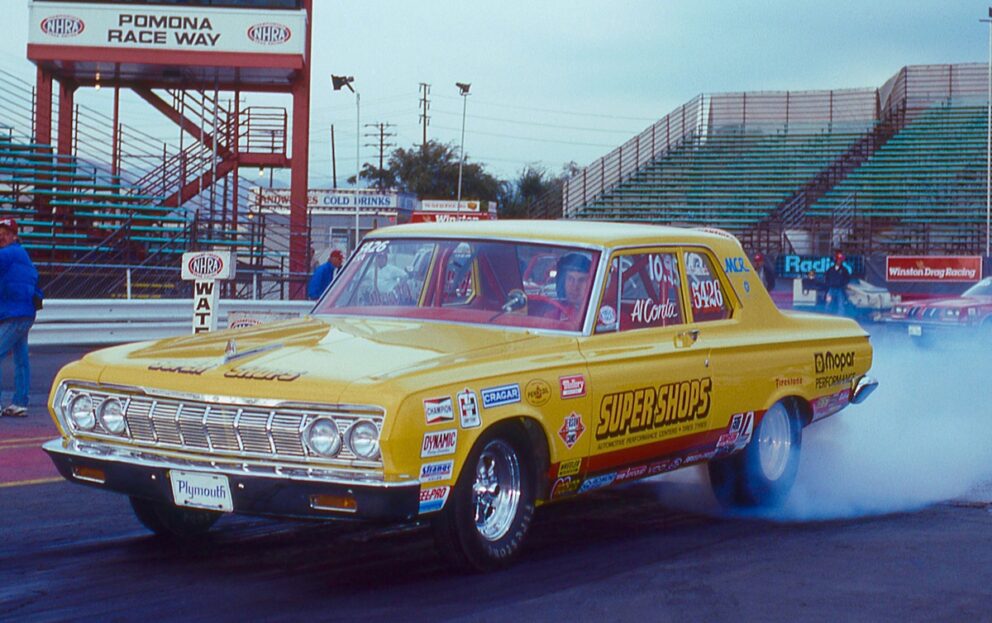
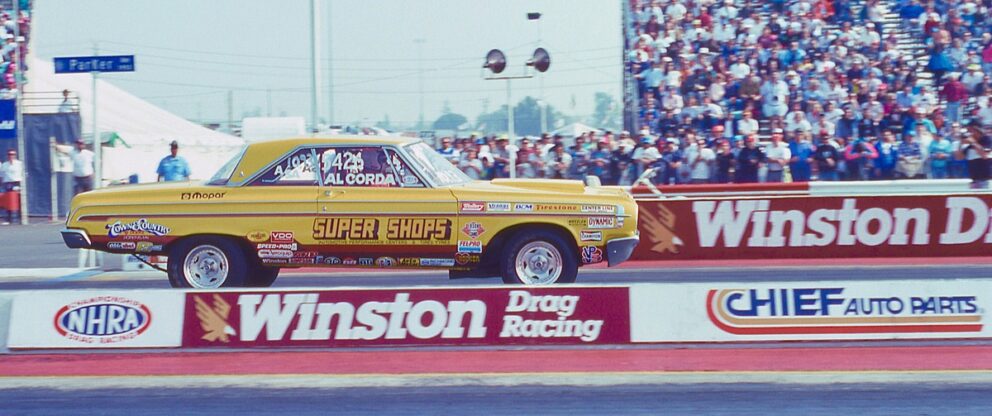
Super Shops sponsorships expanded into the sportsman category, including Al Corda’s high 10-second Max Wedge cars (’64 Plymouth sedan and ’64 Dodge hardtop, both as raced during 1991) which ran in A/Stock Automatic class. As with the other Super Shops’ sponsored cars, emblazoned with Mallory Ignition and Erson Cams markings.
MERCH

As a fun flashback to speed shop “days gone by”, there are a couple of online resources for finding re-pops of the original Super Shops T-shirts, and there’s no question that wearing one of these at a drag strip or car show is bound to bring up some conversations! Be it reminiscing about the actual stores, the Super Shops Arrow Funny Cars, or the Don Garlits and Eddie Hill Top Fuel sponsorships, there’s a good opportunity for some enjoyable trips down memory lane.
Author: James Maxwell
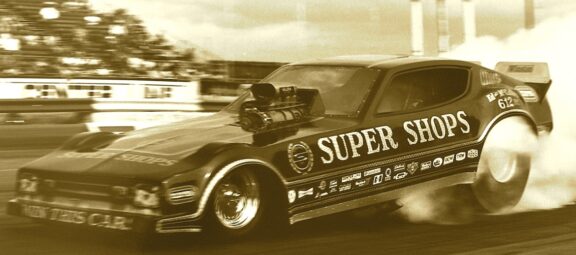
0 Comments